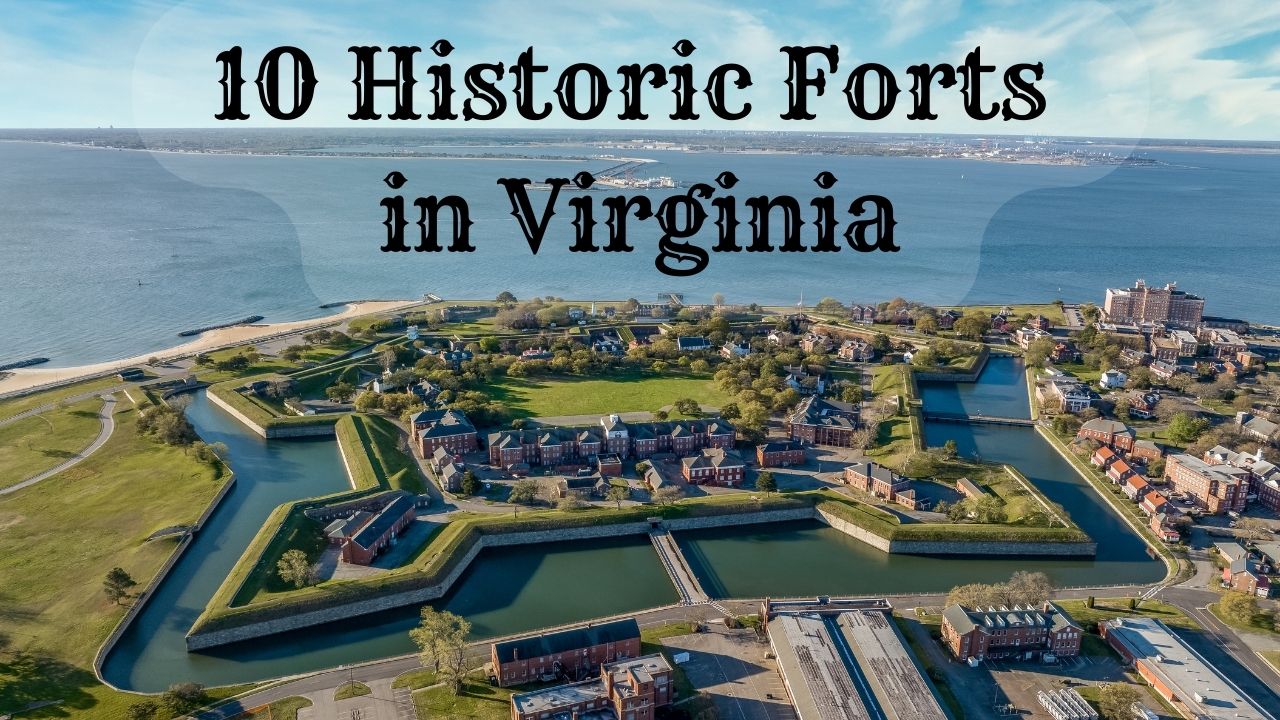Nestled amidst Virginia’s verdant landscapes and rolling hills lie testaments to a turbulent and decisive past.
Virginia’s historic forts are not merely stone and mortar; they are enduring symbols of the struggle, determination, and hope that shaped the nation.
From the Jamestown settlement, the first permanent English colony in the Americas, to the critical Civil War fortifications, these forts tell a complex story that intertwines ambition, conflict, and the pursuit of freedom.
Walking through the gates of these forts, one can almost hear the echoes of soldiers marching, the urgent whispers of spies, and the roar of cannon fire.
They reflect an era where lines were drawn, alliances were forged, and destinies were changed forever. Join us on a journey through time as we explore ten historic forts in Virginia, where history is learned and lived.
Experience the palpable echoes of the past that resonate with our present and guide our path to the future.
10 Historic Forts in Virginia
| 1. Fort Monroe | 6. Fort Norfolk |
| 2. Fort Edward Johnson | 7. Fort Ward |
| 3. Fort Clifton | 8. James Fort |
| 4. Fort Magruder | 9. Smith’s Fort |
| 5. Fort Loudoun | 10. Fort Huger |
1. Fort Monroe National Monument
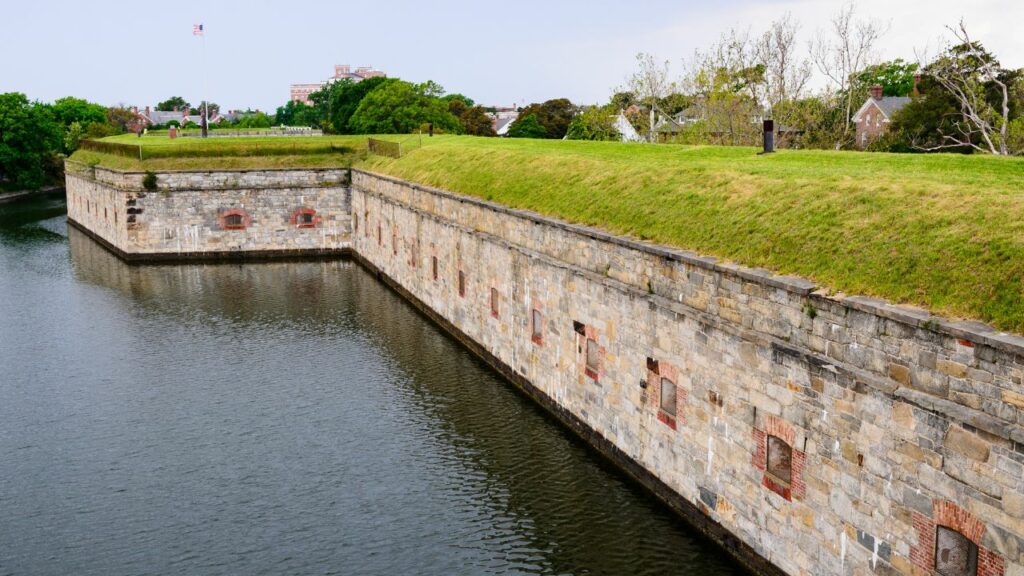
Dominating the picturesque panorama at Old Point Comfort on the James River, the Fort Monroe National Monument is an enduring emblem of American history.
Recognized as the largest stone fort ever constructed in the United States, its imposing presence is matched only by the weight of its historical significance.
Constructed in the early 19th century to protect the mouth of the Chesapeake Bay, this monumental fortification has witnessed defining moments that have shaped American history.
From the American Revolution to the Civil War, each epoch has imprinted its chapter in Fort Monroe’s annals.
Perhaps one of the fort’s most poignant roles was during the Civil War, under the command of Major General Benjamin Butler.
Here, Butler made his groundbreaking ‘Contraband Decision’, declaring escaped slaves as ‘contraband of war’, providing them refuge within the fort’s walls.
This vital decision marked a shift in the dynamics of the Civil War, turning it from a battle for the Union to a battle for freedom, and the fort became a beacon of hope for thousands of African Americans.
Battle of the Ironclads
Lying in the shadow of Fort Monroe, the waters of Hampton Roads bore witness to the famed Battle of the Ironclads. In this pivotal encounter, the CSS Virginia and the USS Monitor clashed in a game-changing naval battle.
The standoff marked a significant turning point in naval warfare, signaling the transition from wooden ships to ironclad war vessels.
Fort Monroe National Monument visitors are welcomed into an immersive historical experience. Visitors can explore the fort’s rich history with free parking and informative interpretive signage.
Tours guide visitors through the fort’s key locations, including the original stone fort, the scene of Butler’s pivotal decision, and the Civil War defenses of Washington. Each stone, each room, echoes with stories of bravery, sacrifice, and revolution that remind us of the resilience and determination of the human spirit.
2. Fort Edward Johnson
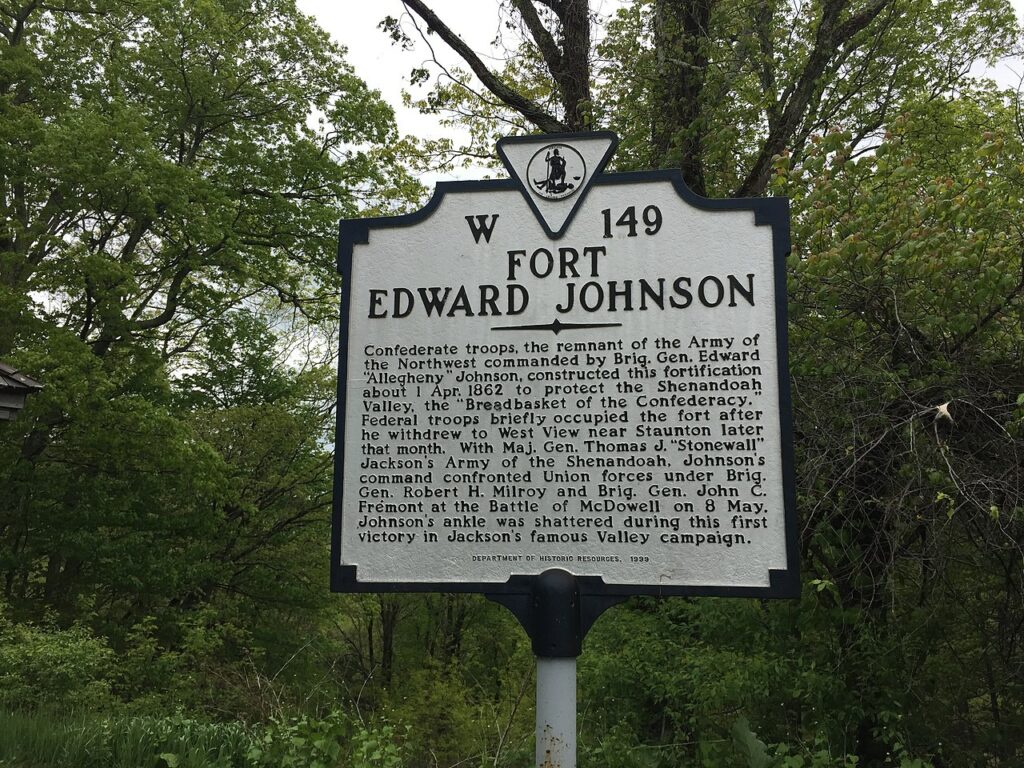
Located atop Shenandoah Mountain in Highland County, Virginia, Fort Edward Johnson bears testament to the strategic maneuvers and tenacious defense tactics of the Confederate forces during the Civil War.
Named after Confederate General Edward “Allegheny” Johnson, the fort played a significant role in the Valley Campaigns of 1862, designed to protect the heartland of the Confederacy from Union incursion.
Guardian of the Shenandoah Valley: The Role of Fort Edward Johnson
Constructed in the early months of 1862, Fort Edward Johnson was situated at a crucial vantage point—on the crest of Shenandoah Mountain.
This elevated position gave Confederate forces an advantageous view of the valleys below, allowing for advanced notice of Union troop movements and providing an opportunity for an organized defense.
General Johnson and his men, also known as the “Mountain Brigade” or “Johnson’s Division,” fortified this location with entrenchments and artillery positions, which are still visible today.
Despite being outnumbered, the Confederate forces stationed at Fort Edward Johnson successfully held off Union attacks for a considerable period before retreating on May 2, 1862, just ahead of the Battle of McDowell.
Fort Edward Johnson Today: A Portal to the Past
Today, Fort Edward Johnson’s site provides a serene and scenic reminder of its turbulent past.
While the fortifications are no longer intact, a historical hiking trail takes visitors along the original breastworks, the artillery positions, and the soldiers’ campsites.
Interpretive signage along the trail provides insights into the fort’s historical significance, the life of the soldiers who occupied it, and the broader context of the Civil War.
A Journey Back in Time: Visiting Fort Edward Johnson
A visit to Fort Edward Johnson is akin to stepping back in time. The tranquil forest, marked by remnants of the fort, tells stories of courage, tenacity, and resilience from a bygone era.
The site offers breathtaking views of the Shenandoah Valley, much like the Confederate soldiers would have had over a century ago.
Outdoor enthusiasts will appreciate the site’s incorporation into the Confederate Breastworks Interpretive Trail, which offers an enriching hike through historical and natural beauty.
Visitors should prepare for a moderate hike, bring appropriate footwear, and respect the area’s historical significance.
3. Fort Clifton
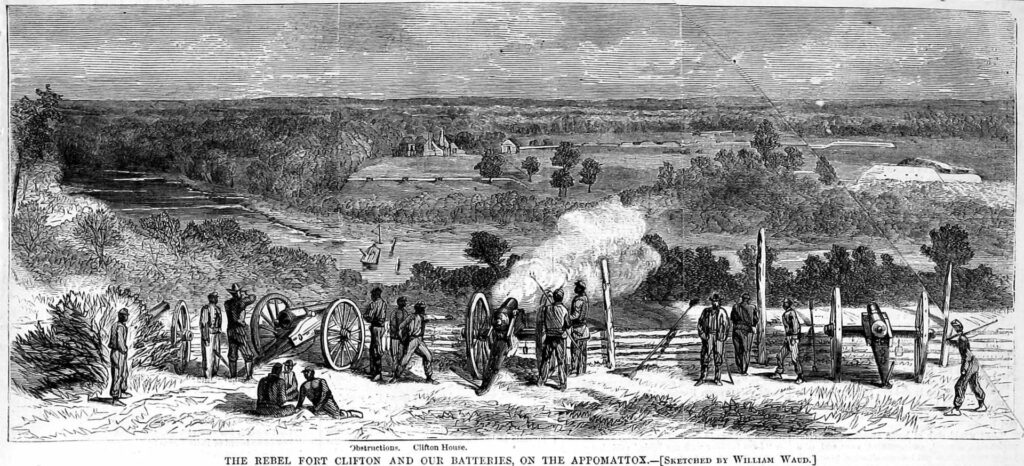
Fort Clifton, nestled in Colonial Heights, Virginia, is indelible in the chronicles of the American Civil War. Sitting on a bluff overlooking the Appomattox River, this former Confederate stronghold was critical in defending Richmond and Petersburg from Union naval assaults.
The Civil War Era: Fort Clifton’s Vital Role
Constructed between 1862 and 1864, Fort Clifton was strategically positioned to command a broad view of the Appomattox River, enabling Confederate forces to control naval traffic and protect crucial supply lines.
The fort was equipped with heavy artillery and earthworks, providing a formidable defense against Union attempts to navigate the river.
Despite numerous skirmishes and attacks, including the significant Battle of Fort Clifton in May 1864, the fort remained in Confederate hands until the fall of Petersburg in April 1865. Its successful defense over this period attests to the strategic importance of the location and the determination of the Confederate forces stationed there.
Preserving History: Fort Clifton Today
In the present day, Fort Clifton serves as a vivid reminder of the past, maintained within the tranquility of Fort Clifton Park. The historic site is dotted with well-preserved earthworks, gun emplacements, and a few original artifacts, including cannonball fragments.
A Walk Through Time: Visiting Fort Clifton
A visit to Fort Clifton offers a unique opportunity to tread in the footsteps of Civil War soldiers. Informative signage details the fort’s history, military significance, and the life of the troops who served there. The park also features an annual Fort Clifton Arts and Crafts Festival, attracting visitors with a mix of local history and culture.
The serene beauty of the park belies its tumultuous past, with stunning views over the Appomattox River providing a picturesque backdrop for picnics, hikes, and strolls.
The site’s interpretive trails meander through history and nature, inviting visitors to contemplate the events unfolding on these grounds over a century ago.
4. Fort Magruder
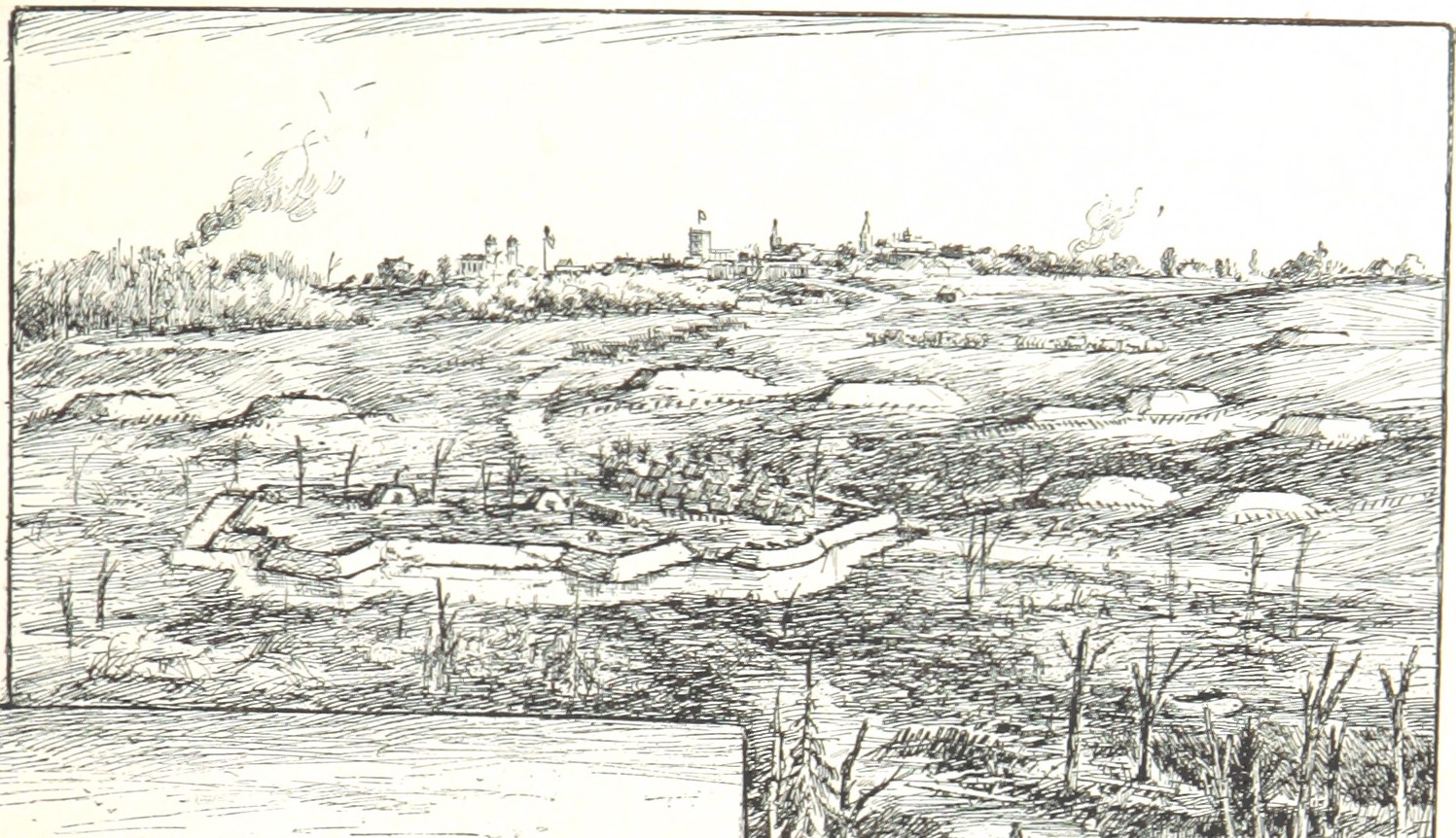
Fort Magruder, located in Williamsburg, Virginia, was a significant site during the American Civil War.
Known for its role in the Battle of Williamsburg in 1862, the fort was a key part of the Confederate defense line, otherwise known as the Williamsburg Line or the Magruder Line, named after Confederate General John B. Magruder.
The Civil War and Fort Magruder: A Strategic Defensive Line
In the heat of the Peninsula Campaign in 1862, Fort Magruder was a critical part of the Confederate defenses designed to delay the Union advance towards Richmond, the Confederate capital.
The fort was one of 14 redoubts established along a roughly four-mile arc. Its strategic depth allowed Confederate forces to safely withdraw during the Battle of Williamsburg.
Despite being outnumbered, the Confederate forces held their line long enough to execute a successful withdrawal, owing in large part to the formidable defenses of Fort Magruder.
The Union forces sustained heavy losses, and although they claimed the battlefield, the delay enabled the Confederates to strengthen the protection of Richmond, altering the course of the Peninsula Campaign.
Preserving the Past: Fort Magruder Today
Today, the area where Fort Magruder once stood has been enveloped mainly by the modern development of Williamsburg.
However, portions of the original fortifications remain intact, offering a poignant reminder of the site’s historical significance.
An interpretive marker has been installed to give visitors historical context and insights into the fort’s role during the Battle of Williamsburg.
A Step Back in Time: Visiting Fort Magruder
Visiting Fort Magruder offers a unique opportunity to walk in the footsteps of history.
The remaining earthworks and the historic marker transport visitors back to the Civil War, allowing them to understand better the strategic maneuvers and high-stakes decisions made during the Battle of Williamsburg.
Although the modern cityscape encroaches on the site, the surviving remnants of Fort Magruder still echo past events as visitors stand where soldiers once fought.
The serene surroundings of the present contrast starkly with the turmoil of the past, offering a place for quiet reflection on the sacrifices made and the course of history that unfolded from these grounds.
5. Fort Loudoun
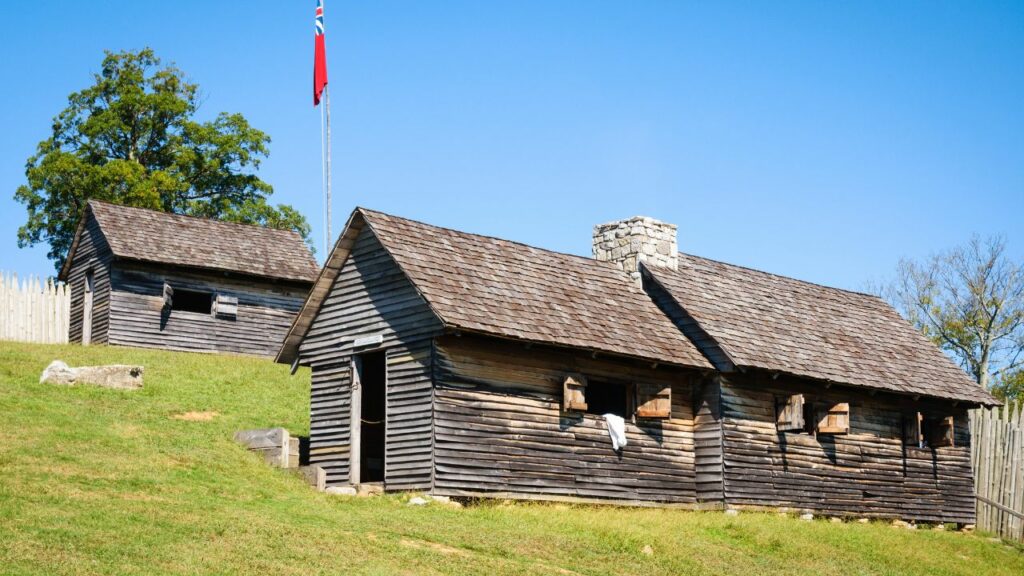
Nestled within the historic landscape of Winchester, Virginia, Fort Loudoun holds a significant place in the chronicles of America’s colonial history.
Fort Loudoun, named after John Campbell, the Fourth Earl of Loudoun and a commander during the French and Indian War, was built between 1756 and 1758 under the guidance of a young Colonel, George Washington.
During escalating tensions and conflict in the Ohio River Valley between the French and British colonies, Washington, then a 24-year-old colonel of the Virginia Regiment, constructed Fort Loudoun as a key defensive position.
The fort was one of several fortifications erected to shield the frontier settlers from French and Native American attacks. Its high walls, strong bastions, and deep, dry moat witnessed countless battles and skirmishes of the French and Indian War.
Fort Loudoun Today: A Portal into the Past
While no original structures stand today, Fort Loudoun’s site has been meticulously preserved and interpreted. Visiting the grounds allows one to imagine the robust activity that once filled the space.
Markers indicate the location of the original walls, barracks, storerooms, and Washington’s quarters. The well, a remarkable feat of engineering dug by the soldiers to a depth of 103 feet, remains the sole intact feature of the fort.
Today’s visit to the Fort Loudoun site is a step back in time. The Fort Loudoun Historic Site is managed by the French and Indian War Foundation, which has tried to preserve the site and educate visitors about its historical significance.
Walking tours, led by knowledgeable guides, offer intriguing insights into the fort’s strategic design and pivotal role in the French and Indian War.
6. Fort Norfolk

Strategically positioned along the Elizabeth River in Norfolk, Virginia, Fort Norfolk is a venerable witness to over two centuries of America’s maritime and military history.
Dating back to the late 18th century, this historic site, one of the original 19 harbor-front forts authorized by President George Washington in 1794, played a pivotal role in defending the coastline and ensuring the country’s survival in times of conflict.
The War of 1812 particularly marked Fort Norfolk’s significance when it served as a central line of defense against British incursions.
Equipped with cannons and a garrison of soldiers, the fort protected the crucial maritime routes and the burgeoning port city of Norfolk.
Civil War and Beyond: Fort Norfolk’s Continued Significance
During the Civil War, Fort Norfolk’s strategic importance persisted.
Serving as a supply depot, it safeguarded the valuable resources crucial for the Union Army’s operations in the area. After the war, as the nation rebuilt, the fort became a naval magazine, continuing its maritime legacy.
Fort Norfolk Today: A Preserved Legacy
Today, Fort Norfolk is one of the few remaining waterfront forts from President Washington’s original 19, making it a treasured relic of America’s early military history.
It has been lovingly restored and preserved and stands not just as a symbol of the nation’s past but as an important educational resource.
Visitors to Fort Norfolk can explore the original fort’s casemates, the fortified earthen walls, the barracks, and the officers’ quarters, providing a unique insight into the military life of the past.
They can also stroll along the waterfront, where the historic naval magazine and several antique cannons remain displayed.
Exploring Fort Norfolk: A Walk Through History
Guided tours offer a deeper dive into the fort’s rich history, including its role in the War of 1812 and the Civil War.
The fort’s unique architecture, impressive collections of military memorabilia, and stunning views of the Elizabeth River also provide countless opportunities for photography and leisurely exploration.
7. Fort Ward Museum & Historic Site
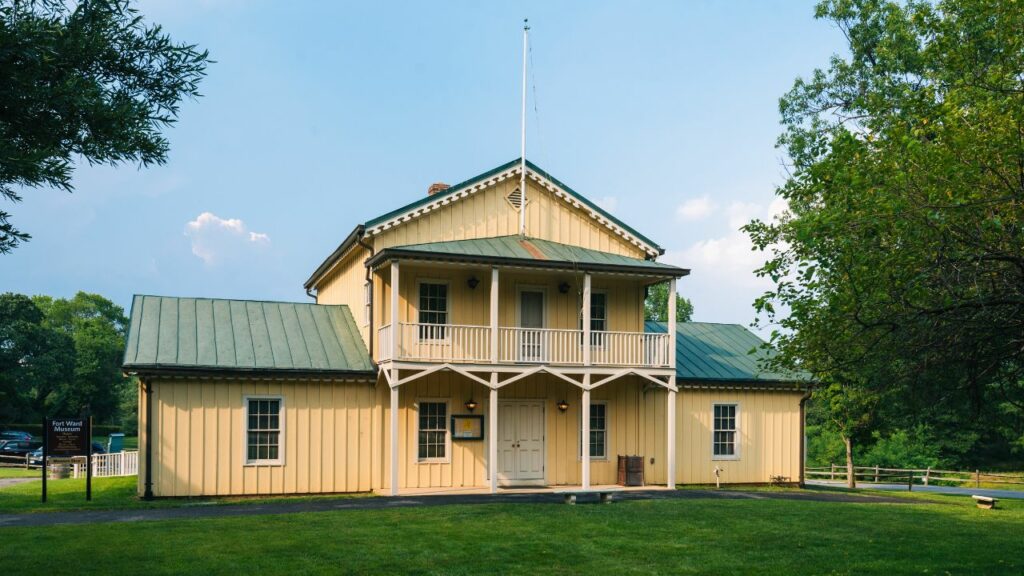
With its strategic position and formidable design, Fort Ward stood as one of the most significant fortifications, serving a critical role in defending the nation’s capital from Confederate forces.
Bearing Witness to Battle: Fort Ward During the Civil War
The fort’s five-bastion design reflected the military engineering of the time. It was equipped to house 500 to 1,000 troops and 36 cannons and mortars.
Fort Ward played an essential role in the Civil War, housing one of the most extensive networks of military roads, fortifications, and batteries in the Union’s defense system.
From Fortification to Preservation: The Journey of Fort Ward
Following the Civil War, Fort Ward and its structures gradually fell into disrepair, succumbing to nature and time. However, recognizing its historical significance, the City of Alexandria took steps to preserve and restore the site.
In the early 1960s, a significant portion of Fort Ward was renovated, with its walls and structures carefully restored to their original 1864 appearance.
Fort Ward Today: Stepping Back in Time
Today, Fort Ward Museum & Historic Site presents a vivid snapshot of Civil War history, allowing visitors to step back in time and witness the past firsthand.
The preserved fort, including its refurbished bastions, gun platforms, powder magazine, and officers’ hut, provides a unique glimpse into military life during the Civil War.
Visitors can stroll along the fort’s original parade ground, explore the museum’s comprehensive collection of Civil War artifacts, or partake in one of the many historical programs and tours offered throughout the year. The site also includes a restored period garden, adding tranquility to this historical landmark.
8. James Fort

Situated on the banks of the James River in Virginia, James Fort, often referred to as Jamestown Fort, holds a singularly important place in American history.
Established in 1607 by the Virginia Company of London, this fort marks North America’s first permanent English settlement.
It was the cradle of British colonial ambition, where the seeds of what would become the United States were first sown.
The Early Years: Struggles and Triumphs
In its early years, the settlers at James Fort faced numerous hardships. Famine, disease, and conflicts with the indigenous Powhatan Confederacy all threatened the survival of the developing community.
Yet, despite these adversities, the fort endured. Over time, it grew into the thriving colonial town of Jamestown, shaping the cultural, political, and economic foundations of colonial America.
Archaeological Discoveries: Unearthing Hidden Histories
Over the centuries, the location of the original James Fort was lost to history.
However, in the 1990s, extensive archaeological excavations by the Jamestown Rediscovery Project located the fort’s original site and unearthed a treasure trove of artifacts.
These finds have provided a wealth of insights into the lives of the early colonists and their interactions with the Native Americans.
James Fort Today: A Window into the Past
Today, James Fort is a prominent feature of Historic Jamestowne, a cultural heritage site jointly administered by the National Park Service and the Jamestown Rediscovery Foundation.
The site showcases the reconstructed palisades, barracks, and churches based on archaeological findings and historical records.
Visiting James Fort: A Journey Through Time
Visitors to James Fort can immerse themselves in the colonial era, exploring the reconstructed buildings, walking in the footsteps of the early settlers, and viewing the array of artifacts in the Archaearium museum.
Regularly held living history events bring the past to life, with historical interpreters demonstrating period skills and narrating the stories of the fort’s earliest days.
9. Smith’s Fort

Nestled in Surry County, Virginia, Smith’s Fort carries a unique narrative deeply intertwined with the birth of America.
The fort’s origin traces back to the pivotal era of the Jamestown settlement, when Captain John Smith, the prominent leader of the early English colonists, conceived plans for a fortification on this site.
The Unfinished Endeavor: History of Smith’s Fort
Smith envisioned the fort as a fallback position for the Jamestown colonists, a stronghold that could provide a critical line of defense against potential threats.
In 1609, construction of the fort began on a high bluff overlooking Gray’s Creek, a tributary of the James River.
However, this ambitious project was left unfinished when Smith had to return to England due to a gunpowder injury. This left behind an uncompleted fort and a historical imprint that would endure the test of time.
Archaeological Investigations: Unraveling the Past
Centuries later, archaeological investigations led by the Association for the Preservation of Virginia Antiquities revealed the fort’s remnants, including defensive ditches and a palisade.
These findings and numerous artifacts unearthed during excavations have provided invaluable insights into the Virginia Colony’s early history and its settlers’ lives.
Smith’s Fort Today: Preserving the Past
Today, Smith’s Fort is a significant landmark, offering visitors a glimpse into the early days of English colonial America.
Although the original fort is no longer standing, the site is now home to Smith’s Fort Plantation, a beautiful, well-preserved 18th-century plantation house.
Surrounded by expansive gardens and woodland trails, this historical site offers a unique blend of natural beauty and historical significance.
A Journey into History: Visiting Smith’s Fort
Visitors to Smith’s Fort can explore the plantation house, which showcases elegant Georgian architecture and period furnishings.
The house tour tells the story of the people who lived there, from the wealthy planters of the colonial era to the enslaved Africans who labored on the property.
The site also offers guided tours detailing the history of the unfinished fort, its strategic importance, and its association with Captain John Smith. F
or those who love to explore nature, the site offers picturesque woodland trails leading to the fort’s archaeological site, providing a serene journey through the landscape the early colonists once traversed.
10. Fort Huger
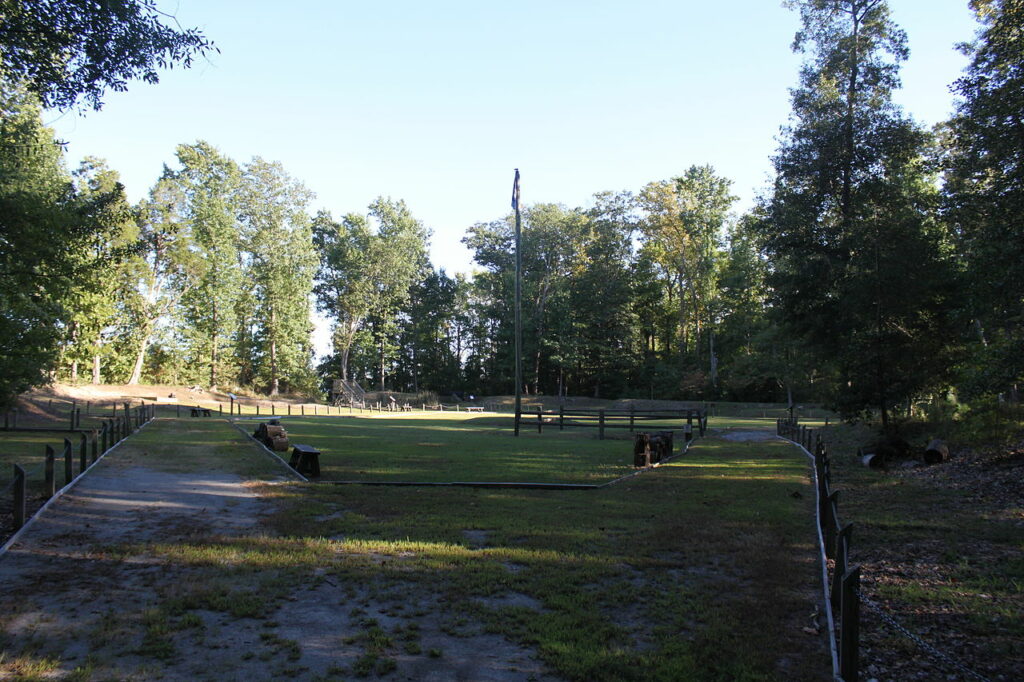
Located on Hardy’s Bluff in Isle of Wight County, Virginia, Fort Huger, known as “the Gateway to the Confederate Capital,” bears the weight of a storied past.
Established during the American Civil War, this significant Confederate fortification was pivotal in controlling access to the James River, a key strategic objective for Union and Confederate forces.
A Critical Position: The Role of Fort Huger
Constructed in 1861 under the direction of General Robert E. Lee, Fort Huger was part of a network of defenses designed to protect the Confederate capital, Richmond. Its strategic location on the James River and its commanding artillery position allowed Confederate forces to defend against Union naval advances.
The Fall and Recovery of Fort Huger
Despite its strategic importance, Fort Huger fell to Union forces during a naval assault in 1862. However, its significance was not forgotten.
In 2007, more than a century after its abandonment, Fort Huger was opened to the public as a historic park, with its original features faithfully restored.
Fort Huger Today: A Walk Through the Past
Today, Fort Huger Historical Park offers a unique journey into the tumultuous era of the Civil War.
A self-guided tour with interpretive signs leads visitors around the earthworks, gun emplacements, and strategic points of the fort, providing insight into its design, operational history, and its role in the broader context of the Civil War.
Engaging Visitors: The Experience of Fort Huger
Visitors can walk in the footsteps of Confederate soldiers, observe the strategic view of the James River that the fort’s occupants would have had, and imagine the explosive exchanges between Union and Confederate forces.
The park also features a 3D model of the fort, offering a bird’s eye perspective of Fort Huger’s appearance in its prime.
Related: 11 Historic Forts in West Virginia
Conclusion – Historic Forts in Virginia
From the shores of the Potomac to the verdant landscapes of Surry County, the historic forts of Virginia offer a tangible connection to the rich tapestry of American history.
These formidable strongholds, whether standing as majestic ruins or meticulously restored landmarks, not only encapsulate pivotal moments from various eras—such as the Revolutionary War, the Civil War, and the Indian Wars—but also embody the spirit of resilience and innovation that has shaped our nation.
As we explore these hallowed sites, we step into a living history book that offers valuable insights into our past and prompts a deeper understanding of the sacrifices and triumphs that have led us to the present.
With their stories forever imprinted in Virginia’s soil, these forts stand as powerful testaments to our collective heritage, inviting us all to remember, learn, and reflect.
If you have visited any of these or other historic forts in Virginia, we would love to hear about your experience in the comments section below.
Frequently Asked Questions (FAQ)
What is the historical significance of Fort Monroe?
Fort Monroe, located on Old Point Comfort at the mouth of the Chesapeake Bay, played a crucial role in protecting the James River and Hampton Roads throughout the centuries. Initially established by Captain John Smith, Fort Monroe’s strategic location facilitated its involvement in the Union Army’s efforts during the Civil War. Moreover, Fort Monroe was essential in developing local militia and provided a refuge for runaway slaves.
How was Fortress Monroe involved in the Civil War?
Fort Monroe remained under Union forces’ control throughout the Civil War. Its strategic position allowed it to act as a base for northern Virginia operations and played a significant role in the famous Battle of Hampton Roads. In this battle, the USS Monitor and the CSS Virginia, two pioneering ironclad ships, engaged in pivotal naval warfare, revolutionizing the future of naval combat.
What role did Fort Monroe play in slavery?
In 1861, Major General Benjamin Butler declared that the runaway slaves seeking refuge at Fort Monroe would be deemed “contraband of war” as their labor aided the Confederate forces. This allowed over 10,000 slaves to find safety and freedom at Fort Monroe during the Civil War. Fort Monroe later became known as the “Freedom Fortress.”
Which forts can be visited in Virginia?
Apart from Fort Monroe, several historic forts are open for public visits in Virginia. Some notable defenses include Fort Loudoun in Frederick County, Fort Nelson in Portsmouth, Fort Boykin in Isle of Wight County, and Fort Wool in Hampton Roads. These forts have been part of various conflicts, such as the Indian War, the American Revolution, and the Civil War. They offer visitors guided tours, interpretive signage, and archaeological investigation opportunities.
Is Fort Monroe currently an active military base?
Fort Monroe was decommissioned as an active military base in 2011. Today, it is managed by the National Park Service and serves as the Fort Monroe National Monument. Visitors can explore historic buildings, the Casemate Museum, and the Chapel of the Centurion, among other attractions. Free parking is available, and the site offers self-guided tours and programs led by knowledgeable park staff.
Who were some famous prisoners at Fort Monroe?
Fort Monroe has detained several high-profile prisoners. During the Civil War, the fort held Confederate President Jefferson Davis after his capture by Union troops. Additionally, two notable Native American leaders, Chief Black Hawk and his son, Whirling Thunder, were once held at Fort Monroe following the 1832 Black Hawk War.

Cory is a website owner and content creator who enjoys fishing, history, coin collecting, and sports, among other hobbies. He is a husband and father of four.
Romans 15:4 For whatever was written in former days was written for our instruction, that through endurance and through the encouragement of the Scriptures we might have hope.

